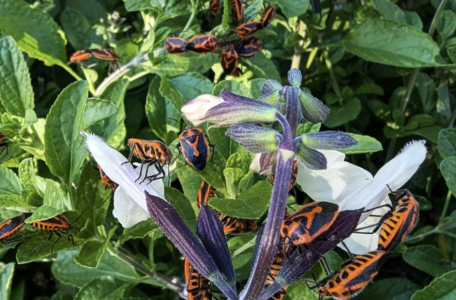This common 'cluster' discovery on trees prompts warning to gardeners of harmful effects
By
Seia Ibanez
- Replies 13
Gardening is a beloved pastime for many Australians.
It offers a chance to connect with nature, cultivate beautiful spaces, and even grow fresh produce.
However, it's not without its hazards, as one Canberra-based gardener recently discovered.
The sighting of a cluster of bright orange stink bugs, known as horehound bugs, clinging to her perennial salvias has prompted a warning to all green thumbs: handle with care!
These insects, while small, pack a punch with their defensive mechanisms. The horehound bugs (Agonoscelis rutila), members of the stink bug family (Pentatomidae), can emit a liquid that is not only foul-smelling but can also cause a burning sensation on skin and eyes.
This is nature's way of protecting them from predators, but it can be quite a shock to an unsuspecting gardener.
The Canberra gardener's experience, shared on social media, has sparked a conversation within the gardening community.
‘I don't use pesticides in my garden,’ she wrote, asking the community if ‘anyone else had success or ideas on control’.
‘Stink bugs usually on citrus new growth. Be careful as they squirt liquid that can burn your eyes and skin that’s why you need to cover up,’ one person said.
Nicole Gunter, Scientist and Curator of Entomology at the Queensland Museum, echoed the person’s response.
‘Horehound bugs (agonoscelis rutila) are members of the stink bug family (pentatomidae),’ she said.
[They] are well-known for their odorous defensive chemicals they release when they are disturbed, which can deter predators.’
‘The compounds can be irritants to human skin, and if in contact with the eyes. If exposed, it's best to rinse the area with water, and then if irritation persists, seek medical advice.’
Gunter added that ‘it’s best to leave them be’ as they won’t harm plants, humans, or pets.
‘However, given they often aggregate in larger clusters, many gardeners may want to remove them, but if they do, it's best to wear gloves,’ she said.
The online community shared creative solutions.
‘Put a bucket of soap water under the bush and shake them into it, or l use long BBQ tongs to lift them off into the bucket and make sure they drown,’ one person said.
‘Use all safety measures, mask, gloves and glasses, and remove them and put them in a bucket of boiling water. They will destroy the plant they are on very quickly,’ said another.
The horehound bug is not a rare sight in Australia, particularly along the eastern seaboard, parts of southern South Australia, and the south-west of Western Australia.
In a previous story, a Channel Nine presenter shared that her fingers turned yellow due to an infestation.
This left her fans guessing what ‘disgusting critter’ she encountered in her home. You can read more about her story here.

Have you encountered horehound bugs or other garden pests? How do you deal with them while keeping yourself safe? Share your stories and tips in the comments below!
It offers a chance to connect with nature, cultivate beautiful spaces, and even grow fresh produce.
However, it's not without its hazards, as one Canberra-based gardener recently discovered.
The sighting of a cluster of bright orange stink bugs, known as horehound bugs, clinging to her perennial salvias has prompted a warning to all green thumbs: handle with care!
These insects, while small, pack a punch with their defensive mechanisms. The horehound bugs (Agonoscelis rutila), members of the stink bug family (Pentatomidae), can emit a liquid that is not only foul-smelling but can also cause a burning sensation on skin and eyes.
This is nature's way of protecting them from predators, but it can be quite a shock to an unsuspecting gardener.
The Canberra gardener's experience, shared on social media, has sparked a conversation within the gardening community.
‘I don't use pesticides in my garden,’ she wrote, asking the community if ‘anyone else had success or ideas on control’.
‘Stink bugs usually on citrus new growth. Be careful as they squirt liquid that can burn your eyes and skin that’s why you need to cover up,’ one person said.
Nicole Gunter, Scientist and Curator of Entomology at the Queensland Museum, echoed the person’s response.
‘Horehound bugs (agonoscelis rutila) are members of the stink bug family (pentatomidae),’ she said.
[They] are well-known for their odorous defensive chemicals they release when they are disturbed, which can deter predators.’
‘The compounds can be irritants to human skin, and if in contact with the eyes. If exposed, it's best to rinse the area with water, and then if irritation persists, seek medical advice.’
Gunter added that ‘it’s best to leave them be’ as they won’t harm plants, humans, or pets.
‘However, given they often aggregate in larger clusters, many gardeners may want to remove them, but if they do, it's best to wear gloves,’ she said.
The online community shared creative solutions.
‘Put a bucket of soap water under the bush and shake them into it, or l use long BBQ tongs to lift them off into the bucket and make sure they drown,’ one person said.
‘Use all safety measures, mask, gloves and glasses, and remove them and put them in a bucket of boiling water. They will destroy the plant they are on very quickly,’ said another.
The horehound bug is not a rare sight in Australia, particularly along the eastern seaboard, parts of southern South Australia, and the south-west of Western Australia.
In a previous story, a Channel Nine presenter shared that her fingers turned yellow due to an infestation.
This left her fans guessing what ‘disgusting critter’ she encountered in her home. You can read more about her story here.
Key Takeaways
- Gardeners are advised to be cautious and wear gloves when handling stink bugs due to their ability to squirt an irritating liquid.
- A Canberra-based gardener found a cluster of bright orange horehound bugs on her salvias, prompting discussions on pest control without pesticides.
- Nicole Gunter, an entomologist, highlighted that horehound bugs can emit odorous chemicals when disturbed, which may irritate skin and eyes.
- It is recommended to leave horehound bugs undisturbed if possible, but if removal is necessary, use protective measures and submerge them in soapy or boiling water to mitigate risks.








